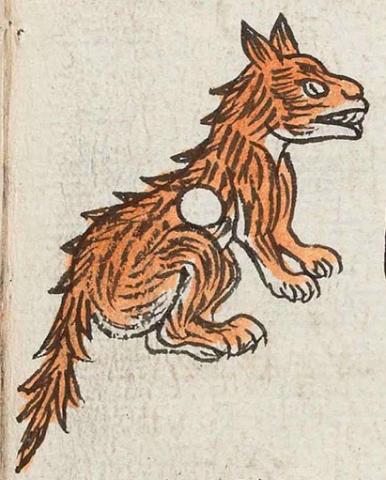Coyohuacan (Mdz47r)
This compound glyph for the place name Coyohuacan (Coyoacán, today, "Place That Has Coyotes") has two principal elements, a coyote (coyotl) and a hole (coyoctli) in the body of the animal. The coyote is sitting on its haunches, with its front legs extended. It is in profile, facing to the viewer's right. Its red tongue is protruding. The locative suffix (-can), which says "where," is not shown visually. The second feature is hole, a small circle, white in the middle and located on the animal's side, between the abdomen and the back. The animal has a terracotta color. Black lines show a texturing of the animal's coat, and wispy hairs stick out on the animal's back. A tail extends out a bit from the animal, on the viewer's left.
Stephanie Wood
The "coyoc-" of hole provides a phonetic reinforcement for the "coyo" of coyote. This helps clarify that this is not a dog. Erik Velásquez García (2019, 77) discusses this KOYO-KOYO combination of logogram (coyote) and rebus (hole). The -hua- is a possessor suffix that attaches to nouns. This is to say that this is a place that has coyotes.
Stephanie Wood
coyoacan. puo
Coyoacan, pueblo
Stephanie Wood
c. 1541, but by 1553 at the latest
Stephanie Wood
coyotes, holes, nombres de lugares

coyo(tl), coyote, https://nahuatl.wired-humanities.org/content/coyotl
coyoc(tli), hole, https://nahuatl.wired-humanities.org/content/coyoctli
-hua- or -huah (possessor suffix), https://nahuatl.wired-humanities.org/content/hua
Coyohuacan, an important altepetl south of Mexico City, https://nahuatl.wired-humanities.org/content/coyohuacan
-can (locative suffix), https://nahuatl.wired-humanities.org/content/can-2
"Place Where People Have Coyotes" [Frances Karttunen, unpublished manuscript, used here with her permission.]
"Place of the Lean Coyotes" (Berdan and Anawalt, 1992, vol. 1, p. )
Donde Tienen Coyotes
Stephanie Wood
Codex Mendoza, folio 47 recto, https://digital.bodleian.ox.ac.uk/objects/2fea788e-2aa2-4f08-b6d9-648c00..., image 104 of 188.
The Bodleian Libraries, University of Oxford, hold the original manuscript, the MS. Arch. Selden. A. 1. This image is published here under the UK Creative Commons, “Attribution-NonCommercial-ShareAlike 3.0 License” (CC-BY-NC-SA 3.0).





